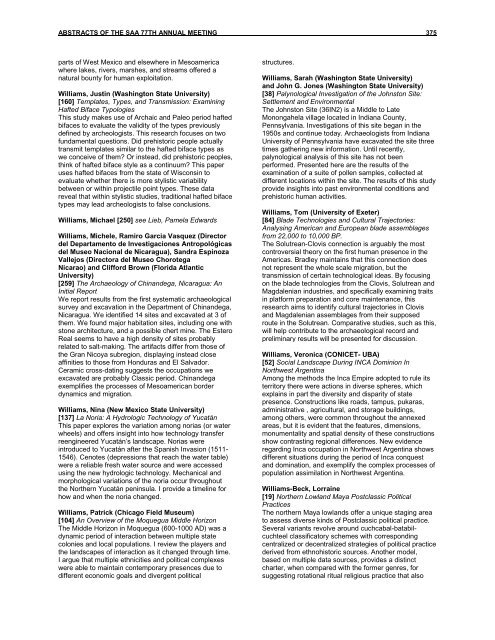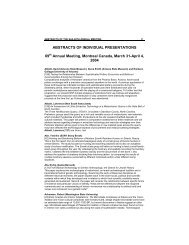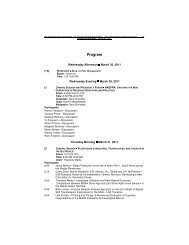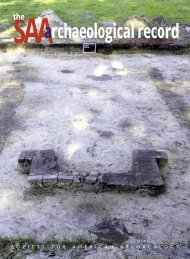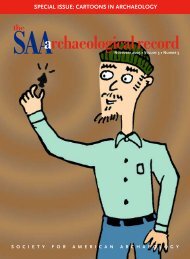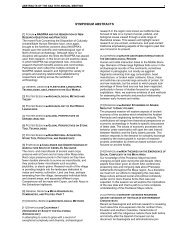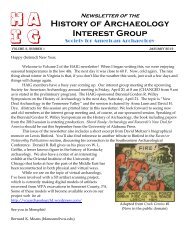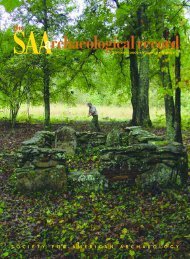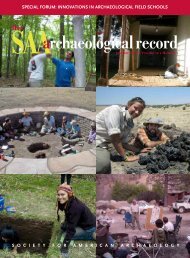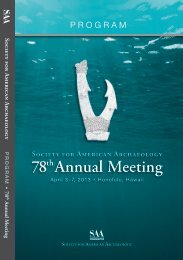Download Individual Abstracts, T through Z - Society for American ...
Download Individual Abstracts, T through Z - Society for American ...
Download Individual Abstracts, T through Z - Society for American ...
You also want an ePaper? Increase the reach of your titles
YUMPU automatically turns print PDFs into web optimized ePapers that Google loves.
ABSTRACTS OF THE SAA 77TH ANNUAL MEETING 375parts of West Mexico and elsewhere in Mesoamericawhere lakes, rivers, marshes, and streams offered anatural bounty <strong>for</strong> human exploitation.Williams, Justin (Washington State University)[160] Templates, Types, and Transmission: ExaminingHafted Biface TypologiesThis study makes use of Archaic and Paleo period haftedbifaces to evaluate the validity of the types previouslydefined by archeologists. This research focuses on twofundamental questions. Did prehistoric people actuallytransmit templates similar to the hafted biface types aswe conceive of them? Or instead, did prehistoric peoples,think of hafted biface style as a continuum? This paperuses hafted bifaces from the state of Wisconsin toevaluate whether there is more stylistic variabilitybetween or within projectile point types. These datareveal that within stylistic studies, traditional hafted bifacetypes may lead archeologists to false conclusions.Williams, Michael [250] see Lieb, Pamela EdwardsWilliams, Michele, Ramiro Garcia Vasquez (Directordel Departamento de Investigaciones Antropológicasdel Museo Nacional de Nicaragua), Sandra EspinozaVallejos (Directora del Museo ChorotegaNicarao) and Clif<strong>for</strong>d Brown (Florida AtlanticUniversity)[259] The Archaeology of Chinandega, Nicaragua: AnInitial ReportWe report results from the first systematic archaeologicalsurvey and excavation in the Department of Chinandega,Nicaragua. We identified 14 sites and excavated at 3 ofthem. We found major habitation sites, including one withstone architecture, and a possible chert mine. The EsteroReal seems to have a high density of sites probablyrelated to salt-making. The artifacts differ from those ofthe Gran Nicoya subregion, displaying instead closeaffinities to those from Honduras and El Salvador.Ceramic cross-dating suggests the occupations weexcavated are probably Classic period. Chinandegaexemplifies the processes of Mesoamerican borderdynamics and migration.Williams, Nina (New Mexico State University)[137] La Noria: A Hydrologic Technology of YucatánThis paper explores the variation among norias (or waterwheels) and offers insight into how technology transferreengineered Yucatán’s landscape. Norias wereintroduced to Yucatán after the Spanish Invasion (1511-1546). Cenotes (depressions that reach the water table)were a reliable fresh water source and were accessedusing the new hydrologic technology. Mechanical andmorphological variations of the noria occur <strong>through</strong>outthe Northern Yucatán peninsula. I provide a timeline <strong>for</strong>how and when the noria changed.Williams, Patrick (Chicago Field Museum)[104] An Overview of the Moquegua Middle HorizonThe Middle Horizon in Moquegua (600-1000 AD) was adynamic period of interaction between multiple statecolonies and local populations. I review the players andthe landscapes of interaction as it changed <strong>through</strong> time.I argue that multiple ethnicities and political complexeswere able to maintain contemporary presences due todifferent economic goals and divergent politicalstructures.Williams, Sarah (Washington State University)and John G. Jones (Washington State University)[38] Palynological Investigation of the Johnston Site:Settlement and EnvironmentalThe Johnston Site (36IN2) is a Middle to LateMonongahela village located in Indiana County,Pennsylvania. Investigations of this site began in the1950s and continue today. Archaeologists from IndianaUniversity of Pennsylvania have excavated the site threetimes gathering new in<strong>for</strong>mation. Until recently,palynological analysis of this site has not beenper<strong>for</strong>med. Presented here are the results of theexamination of a suite of pollen samples, collected atdifferent locations within the site. The results of this studyprovide insights into past environmental conditions andprehistoric human activities.Williams, Tom (University of Exeter)[84] Blade Technologies and Cultural Trajectories:Analysing <strong>American</strong> and European blade assemblagesfrom 22,000 to 10,000 BP.The Solutrean-Clovis connection is arguably the mostcontroversial theory on the first human presence in theAmericas. Bradley maintains that this connection doesnot represent the whole scale migration, but thetransmission of certain technological ideas. By focusingon the blade technologies from the Clovis, Solutrean andMagdalenian industries, and specifically examining traitsin plat<strong>for</strong>m preparation and core maintenance, thisresearch aims to identify cultural trajectories in Clovisand Magdalenian assemblages from their supposedroute in the Solutrean. Comparative studies, such as this,will help contribute to the archaeological record andpreliminary results will be presented <strong>for</strong> discussion.Williams, Veronica (CONICET- UBA)[52] Social Landscape During INCA Dominion InNorthwest ArgentinaAmong the methods the Inca Empire adopted to rule itsterritory there were actions in diverse spheres, whichexplains in part the diversity and disparity of statepresence. Constructions like roads, tampus, pukaras,administrative , agricultural, and storage buildings,among others, were common <strong>through</strong>out the annexedareas, but it is evident that the features, dimensions,monumentality and spatial density of these constructionsshow contrasting regional differences. New evidenceregarding Inca occupation in Northwest Argentina showsdifferent situations during the period of Inca conquestand domination, and exemplify the complex processes ofpopulation assimilation in Northwest Argentina.Williams-Beck, Lorraine[19] Northern Lowland Maya Postclassic PoliticalPracticesThe northern Maya lowlands offer a unique staging areato assess diverse kinds of Postclassic political practice.Several variants revolve around cuchcabal-batabilcuchteelclassificatory schemes with correspondingcentralized or decentralized strategies of political practicederived from ethnohistoric sources. Another model,based on multiple data sources, provides a distinctcharter, when compared with the <strong>for</strong>mer genres, <strong>for</strong>suggesting rotational ritual religious practice that also


